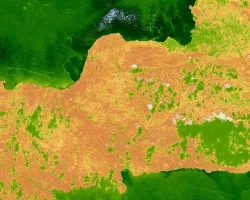Eastern Plains Agriculture (Fall 2022)
Team: Jillian Joubert, Sarah Hettema, Deni Ranguelova, TR Ingram, Max Stewart
Summary: Adaptive management on cattle ranches requires rangeland managers to decide the location and duration of the cattle grazing activity across different pastures. Biodiversity, forage availability, and cattle health are all affected by rangeland management. Virtual fencing is a tool that rangeland managers can use to potentially increase biodiversity and improve ranching operations. NASA DEVELOP and Colorado State University (CSU) collaborated with the Nature Conservancy (TNC) and Red Top Ranch to demonstrate the efficacy of virtual fencing. We sought to identify annual and monthly biomass patterns on the ranch (through the creation of monthly max biomass productivity maps). We utilized a dataset from the Agricultural Research Service (ARS) to calculate biomass on the ranch. To validate our remotely-sensed results, we compared model-predicted biomass values to field-collected biomass clipping data and an additional biomass dataset from the Rangeland Analysis Platform (RAP). We used satellite imagery from Landsat 5 Thematic Mapper (TM), Landsat 7 Enhanced Thematic Mapper Plus (ETM+), Landsat 8 Operational Land Imager (OLI), Landsat 9 Operational Land Imager - 2, and Sentinel-2 MultiSpectral Instrument (MSI) for 2021 and 2022. We found that there was heterogeneity in biomass across the ranch, with higher biomass on the western side. The highest peak of biomass was in the summer months, with a smaller peak in mid-September. The ARS biomass dataset had a significant relationship with RAP for 2021. ARS biomass did not have a significant relationship with the biomass field data collected in 2022. The results of our study are aimed at supporting rotation management, ranch production, biodiversity, and conservation management.



